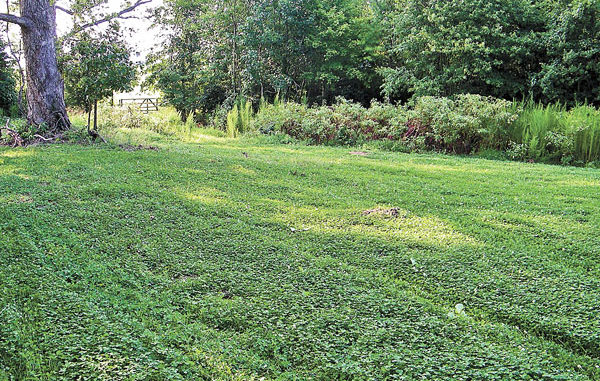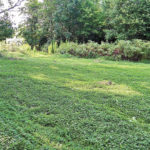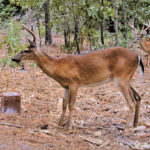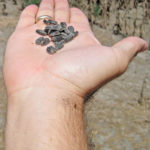
Warm-season food plots supplement deer with a rich source of balanced nutrition over the late spring and summer, during a critical time of need for both male and female deer. Warming soil temperatures and frequent rains provide the newly-planted crops and perennials with ideal conditions to thrive and produce lush forage prized by deer. But grasses and other weedy invaders also covet these juicy conditions, quickly taking root within the food plot. Weeds and other invasive invaders can be controlled chemically and mechanically before and after food-plot establishment.
Most food-plot seeds flourish under ideal conditions with little competition from other plants. But the majority of wildlife foods do not compete well with aggressive weeds and grasses. In nature, exposed soil stimulates early succession, with grasses and weeds growing first, followed by shrubs, then tree saplings. In the first six inches of soil depth, thousands of minuscule seeds exist, prevented from germinating for a number of reasons. Essentially, when raw soil becomes exposed, the race is on for these dormant seeds to germinate and spread like wildfire. Additionally, the exposed pH-balanced soil enhanced with an application of nitrogen, phosphorus, and potassium — “NPK” — accelerates the process.
Weeds must be controlled at various phases of a food plot’s life cycle to maintain effectiveness and establishment of the target species. Generally, plots are sprayed or disced heavily before planting, allowing food-plot seeds the chance to germinate and take hold. But dormant weed seeds in the fertile soil eventually germinate and violate even the perfect food plot. Perennial true-clover plots and spring annuals, such as alyce-clover, lab-lab, joint vetch and peas are tolerant to heavy grazing. In fact, wildlife food-plot species are the most nutritious while they are actively growing. But many common weeds and grasses are more intolerant of heavy cutting or grazing than most food-plot species. For this reason, established perennial food plots and newly-seeded plots should be mowed to discourage weeds from taking control.
These plots should be mowed back before weeds and invasive grasses can form seed heads. Mowing by itself will kill broadleaf weeds such as dandelion and chickweed. Clover plots should be mowed when clover flower heads are half-bloomed to invigorate vegetative growth. Perennial clover and alyce-clover plots, if established effectively, will outcompete weeds and invading grasses quite well, reducing weed problems for part of the year. Perennial clovers’ growth slows in hot, dry summer conditions, and some weeds and grasses tolerant of arid conditions can take hold.
For most of the Carolinas, perennial clover plots and newly-established food plots should be mowed in June.
Refresh mineral sources
If any month is a particularly critical period for mineral uptake for whitetail bucks, June takes the prize, with the remaining summer months also playing into the picture. Bucks’ velveteen antlers are at their highest rate of growth, and supplemental minerals are in high demand. Antler growth begins during the first few days of April and will continue until the blood flow ceases, generally around the middle of August in the Carolinas.
In nature, deer start producing antlers from a biological trigger in their pituitary glands. The lengthening of daylight — photoperiod — in springtime is responsible for this mechanism, starting the process of converting calcium and phosphorous from within the deer’s bones into antler material. Readily-available mineral supplements will offset this process and will help bucks deer reach their full genetic potential in antler growth at their current stage of life. Supplemental minerals also reverse the leaching of phosphorous and calcium from within their bones, allowing deer to remain healthy throughout the summer antler-growing season.
Commercial mineral supplements come in block, rock, powder and granular forms. The shape and consistency of these supplements have little differences, the composition is important. Deer need calcium and phosphorus, and commercial products should be heavily ratioed to these two elements, with calcium concentrations carrying the highest portion. While many contain high levels of salt, supplements should not contain more than one-third its volume in salt. Mineral supplements should be widely-dispersed throughout the property and near water sources to be most effective.
It’s not too late for dove-field plantings!
Labor Day weekend invigorates hunters across the Carolinas, giving them a reason to head out into the fields to take a few tasty, winged delicacies.
While the majority of dove hunters settle around freshly-cut corn fields prepared by local farmers, serious dove hunters gather at fields exclusively planted for doves. Corn, millet, sorghum and sunflowers are the primary planted food sources for doves in the southeast. While June 1 is 90 days away from Opening Day, millet and sorghum can still be planted to provide a productive Labor Day dove shoot.
Dove millet and white proso millet mature in approximately 90 days and should be planted the last few weeks of May or even the first few days of June. Brown-top millet is also a good dove food and matures in as few as 60 to 70 days. Brown-top can be planted towards the end of June and as late as early July to still mature, to allow adequate time for shelling and in time for the opening day hunt.
Generally, dove prefer smaller seed such as millets and sorghums, but these speedy little birds have a serious addiction for sunflower seeds. The nutty-flavored sunflower delights draw doves from miles away. However, June is too late to plant sunflower seeds for the Labor Day hunt. Sunflower seeds mature in approximately 110 to 120 days.
Fortunately for dove hunters in the Carolinas, the long season runs from from Labor Day into January, but split into three distinct seasons. While some doves in the Carolinas are residents, the migrant flocks invade the Carolinas beginning in August and will continue to hammer spent grain fields throughout the winter.
While June plantings are limited to millet and sorghum for the Labor Day weekend hunt, sunflower, sesame and even corn can be planted in June to mature during the later dove seasons in November and December. However, the Carolinas experience freezing temperatures in October, and all plants should be planted to be mature before the first freeze
Plot size will play an important role in dove-field preparation. In order to have a good hunt, at least three to five acres at a minimum, should be planted in one single field. While bumper production of these seed crops are quite common if planted and maintained correctly, mature seeds can be quickly consumed by migrating flocks of doves.
Dove fields larger than 10 acres are recommended to continually attract doves into the areas. Several plantings two to four weeks apart are recommended to produce a constant flow of maturing grain throughout the dove seasons.
Just as all migratory birds, including ducks, geese, and doves, a consistent, rich food source will concentrate these migrating birds and will keep them frequenting and feeding in these areas as food supplies last.
Jeff Burleson is a native of Lumberton, N.C., who lives in Myrtle Beach, S.C. He graduated from N.C. State University with a degree in fisheries and wildlife sciences and is a biologist and professional forester for The Brigman Companies.







Be the first to comment